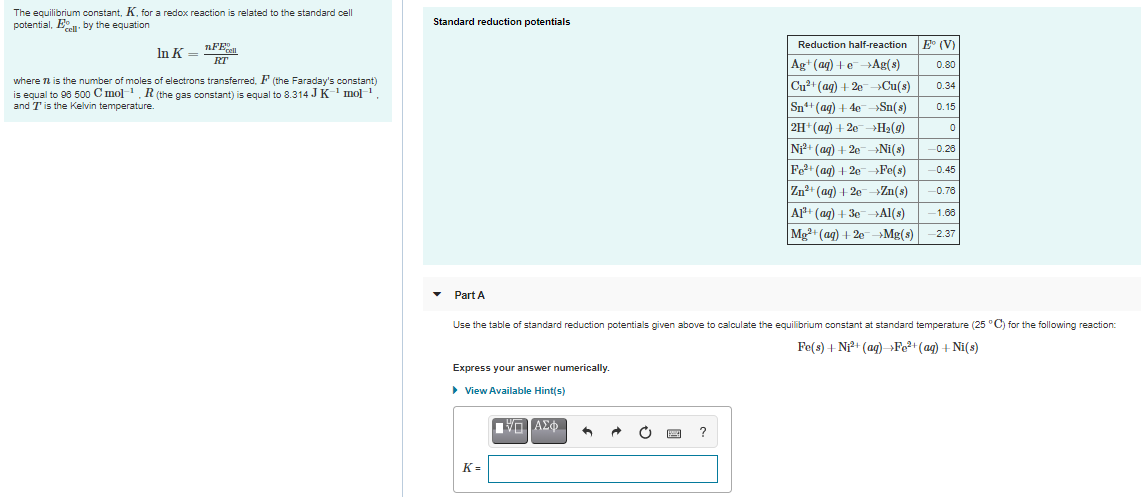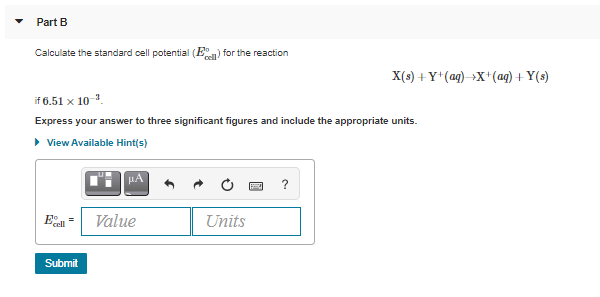The equilibrium constant, K. for a redox reaction is related to the standard cell potential, E by the equation cell nFE In K cel RT where n is the number of moles of electrons transferred, F (the Faraday's constant) is equal to 98 500 C mol. R (the gas constant) is equal to 8.314 JKmol and Tis the Kelvin temperature.
The equilibrium constant, K. for a redox reaction is related to the standard cell potential, E by the equation cell nFE In K cel RT where n is the number of moles of electrons transferred, F (the Faraday's constant) is equal to 98 500 C mol. R (the gas constant) is equal to 8.314 JKmol and Tis the Kelvin temperature.
Chemical Principles in the Laboratory
11th Edition
ISBN:9781305264434
Author:Emil Slowinski, Wayne C. Wolsey, Robert Rossi
Publisher:Emil Slowinski, Wayne C. Wolsey, Robert Rossi
Chapter32: Voltaic Cell Measurements
Section: Chapter Questions
Problem 2ASA
Related questions
Question

Transcribed Image Text:The equilibrium constant, K, for a redox reaction is related to the standard cell
potential, E. by the equation
Standard reduction potentials
In K =
nFE
Reduction half-reaction
E (V)
RT
Ag+(ag) +eAg(s)
0.80
where n is the number of moles of electrons transferred, F (the Faraday's constant)
is equal to 98 500 C mol-1, R(the gas constant) is equal to 8.314 JK-' mol1.
and T is the Kelvin temperature.
Cu2+ (ag) + 20
Cu(s)
0.34
Sn+(ag) + 4e-Sn(s)
0.15
2H+(ag) + 20H2(9)
Ni+ (ag) + 2e-»Ni(s)
Fe+ (ag) + 20Fe(s)
Zn2+ (ag) + 2e→Zn(s)
-0.26
-0.45
-0.76
A1+ (ag) + 30-Al(s)
-1.68
Mg+ (ag) + 20MB(s)
2.37
• Part A
Use the table of standard reduction potentials given above to calculate the equilibrium constant at standard temperature (25 °C) for the following reaction:
Fe(s) + N+ (ag) »Fe2+ (ag) + Ni(s)
Express your answer numerically.
> View Available Hint(s)
?
K =

Transcribed Image Text:Part B
Calculate the standard cell potential (E
cel for the reaction
X(s) +Y*(ag) X+(ag) + Y(s)
if 6.51 x 10 .
Express your answer to three significant figures and include the appropriate units.
• View Available Hint(s)
HA
?
Value
Units
Submit
Expert Solution
This question has been solved!
Explore an expertly crafted, step-by-step solution for a thorough understanding of key concepts.
This is a popular solution!
Trending now
This is a popular solution!
Step by step
Solved in 3 steps

Knowledge Booster
Learn more about
Need a deep-dive on the concept behind this application? Look no further. Learn more about this topic, chemistry and related others by exploring similar questions and additional content below.Recommended textbooks for you

Chemical Principles in the Laboratory
Chemistry
ISBN:
9781305264434
Author:
Emil Slowinski, Wayne C. Wolsey, Robert Rossi
Publisher:
Brooks Cole

Chemistry: The Molecular Science
Chemistry
ISBN:
9781285199047
Author:
John W. Moore, Conrad L. Stanitski
Publisher:
Cengage Learning

Principles of Modern Chemistry
Chemistry
ISBN:
9781305079113
Author:
David W. Oxtoby, H. Pat Gillis, Laurie J. Butler
Publisher:
Cengage Learning

Chemical Principles in the Laboratory
Chemistry
ISBN:
9781305264434
Author:
Emil Slowinski, Wayne C. Wolsey, Robert Rossi
Publisher:
Brooks Cole

Chemistry: The Molecular Science
Chemistry
ISBN:
9781285199047
Author:
John W. Moore, Conrad L. Stanitski
Publisher:
Cengage Learning

Principles of Modern Chemistry
Chemistry
ISBN:
9781305079113
Author:
David W. Oxtoby, H. Pat Gillis, Laurie J. Butler
Publisher:
Cengage Learning

Chemistry: Principles and Reactions
Chemistry
ISBN:
9781305079373
Author:
William L. Masterton, Cecile N. Hurley
Publisher:
Cengage Learning

Chemistry: An Atoms First Approach
Chemistry
ISBN:
9781305079243
Author:
Steven S. Zumdahl, Susan A. Zumdahl
Publisher:
Cengage Learning
